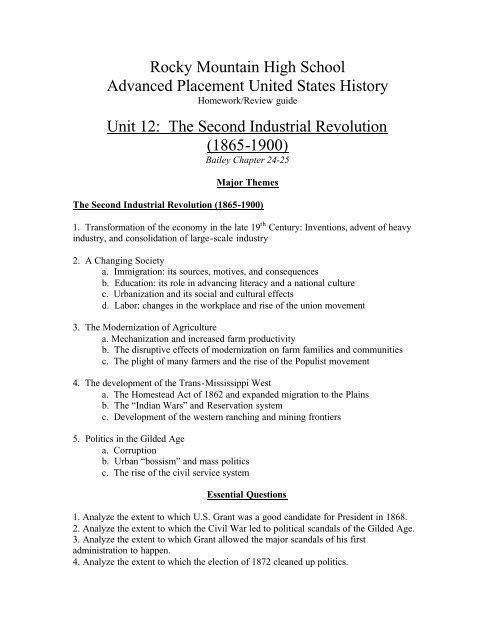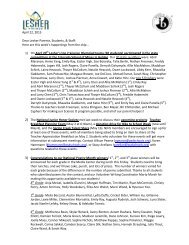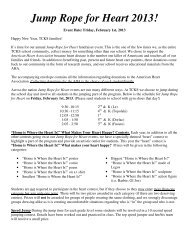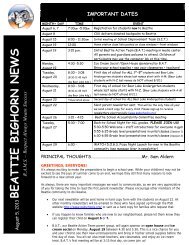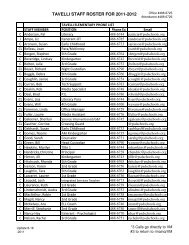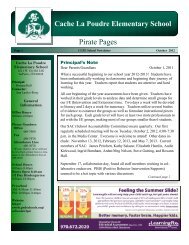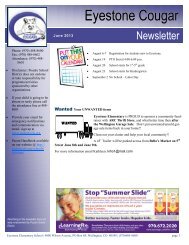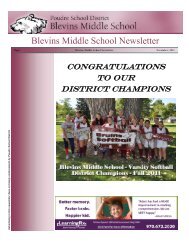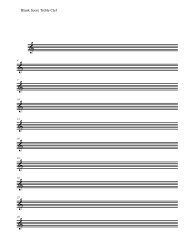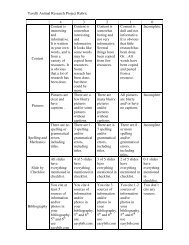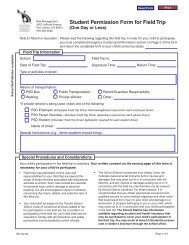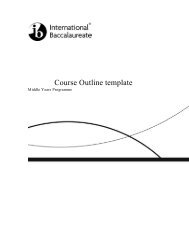APUSH Unit 12 Reading Guide
APUSH Unit 12 Reading Guide
APUSH Unit 12 Reading Guide
Create successful ePaper yourself
Turn your PDF publications into a flip-book with our unique Google optimized e-Paper software.
Rocky Mountain High School<br />
Advanced Placement <strong>Unit</strong>ed States History<br />
Homework/Review guide<br />
<strong>Unit</strong> <strong>12</strong>: The Second Industrial Revolution<br />
(1865-1900)<br />
Bailey Chapter 24-25<br />
Major Themes<br />
The Second Industrial Revolution (1865-1900)<br />
1. Transformation of the economy in the late 19 th Century: Inventions, advent of heavy<br />
industry, and consolidation of large-scale industry<br />
2. A Changing Society<br />
a. Immigration: its sources, motives, and consequences<br />
b. Education: its role in advancing literacy and a national culture<br />
c. Urbanization and its social and cultural effects<br />
d. Labor: changes in the workplace and rise of the union movement<br />
3. The Modernization of Agriculture<br />
a. Mechanization and increased farm productivity<br />
b. The disruptive effects of modernization on farm families and communities<br />
c. The plight of many farmers and the rise of the Populist movement<br />
4. The development of the Trans-Mississippi West<br />
a. The Homestead Act of 1862 and expanded migration to the Plains<br />
b. The “Indian Wars” and Reservation system<br />
c. Development of the western ranching and mining frontiers<br />
5. Politics in the Gilded Age<br />
a. Corruption<br />
b. Urban “bossism” and mass politics<br />
c. The rise of the civil service system<br />
Essential Questions<br />
1. Analyze the extent to which U.S. Grant was a good candidate for President in 1868.<br />
2. Analyze the extent to which the Civil War led to political scandals of the Gilded Age.<br />
3. Analyze the extent to which Grant allowed the major scandals of his first<br />
administration to happen.<br />
4. Analyze the extent to which the election of 1872 cleaned up politics.
5. Analyze the extent to which the Panic of 1873 was caused by the scandal and<br />
corruption of the Grant administration.<br />
6. Analyze the extent to which ethnic and cultural differences led to the partisan nature of<br />
politics during the Gilded Age.<br />
7. Analyze the extent to which the election of 1876 marked a return to the “Old South” of<br />
antebellum days.<br />
8. Analyze the extent to which economic rivalry was the cause of racial tension between<br />
immigrant groups in California during the 1870’s.<br />
9. Analyze the extent to which Garfield created a bridge between the Stalwarts and the<br />
Half-breeds in the election of 1880.<br />
10. Analyze the extent to which president Arthur spurned both the Stalwarts and Halfbreeds<br />
when he came to office in 1881.<br />
11. Analyze the extent to which the debauched election of 1884 underscored the need for<br />
reform in the political party system.<br />
<strong>12</strong>. Analyze the extent to which the first Cleveland administration was influenced by<br />
outside lobby groups.<br />
13. Analyze the extent to which William Harrison’s presidency dealt with the pressing<br />
political issues of the day.<br />
14. Analyze the extent to which the railroads of the post-Civil War period drove the<br />
corruption and scandals of the time.<br />
15. Analyze the extent to which railroads impacted the political, economic and social life<br />
of America after the Civil War.<br />
16. Analyze the extent to which organized agrarian groups led to railroad reform at a<br />
federal level by 1890.<br />
17. Analyze the extent to which inventions and immigrations combined to create a strong<br />
nation after the Civil War.<br />
18. Analyze the extent to which trusts controlled the economy during the Gilded Age.<br />
19. Analyze the extent to which anti-trust legislation was an attempt by lawmakers to<br />
quiet public criticism.<br />
20. Analyze the extent to which the Bonsack cigarette-making machine in 1881 brought<br />
the South back from economic ruin after the Civil War.<br />
21. Analyze the extent to which the rise of industry impacted social groups (migrants,<br />
immigrants, women, blacks, farmers) in the <strong>Unit</strong>ed States.<br />
22. Analyze the extent to which major labor unions (NLU, Knights of Labor, AF of L)<br />
after the Civil War impacted the lives of workers in the <strong>Unit</strong>ed States.
A. Why Grant?<br />
RMHS <strong>APUSH</strong> <strong>Reading</strong> <strong>Guide</strong><br />
<strong>Unit</strong> <strong>12</strong><br />
Chapter 24<br />
The “Bloody Shirt” Elects Grant<br />
24.1<br />
B. Republican platform, 1868<br />
C. Democratic platform, 1868<br />
D. Results<br />
RMHS <strong>APUSH</strong> <strong>Reading</strong> <strong>Guide</strong><br />
<strong>Unit</strong> <strong>12</strong><br />
Chapter 24<br />
The Era of Good Stealings<br />
24.2<br />
A. Physical vs. Moral Stature<br />
B. Political Atmosphere<br />
C. Fisk & Gould<br />
D. Tweed Ring<br />
E. Bringing Tweed down
RMHS <strong>APUSH</strong> <strong>Reading</strong> <strong>Guide</strong><br />
<strong>Unit</strong> <strong>12</strong><br />
Chapter 24<br />
A Carnival of Corruption<br />
A. Why scandal with Grant?<br />
24.3<br />
B. Credit Mobilier<br />
C. Whiskey Ring<br />
D. Belknap Scandal<br />
RMHS <strong>APUSH</strong> <strong>Reading</strong> <strong>Guide</strong><br />
<strong>Unit</strong> <strong>12</strong><br />
Chapter 24<br />
A Liberal Republican Revolt of 1872<br />
24.4<br />
A. Disgust with “Grantism”<br />
B. Liberal Republicans, Democrats, Greeley & “Crow”<br />
C. Mud-slinging<br />
D. Liberal Reps legacy
RMHS <strong>APUSH</strong> <strong>Reading</strong> <strong>Guide</strong><br />
<strong>Unit</strong> <strong>12</strong><br />
Chapter 24<br />
Depression and Demands for Inflation<br />
24.5<br />
A. Panic of 1873 (causes)<br />
B. Jay Cooke & Co.<br />
C. Impact on Blacks<br />
D. Debtors<br />
E. Hard-money, Cheap-money, Soft-money, and Greenbacks<br />
F. Resumption Act, 1875
RMHS <strong>APUSH</strong> <strong>Reading</strong> <strong>Guide</strong><br />
<strong>Unit</strong> <strong>12</strong><br />
Chapter 24<br />
Pallid Politics in the Gilded Age<br />
24.6<br />
A. So many voters, so few choices<br />
B. Ethnic and Cultural Differences<br />
C. GAR<br />
D. Solid South<br />
E. Stalwarts vs. Half Breeds<br />
RMHS <strong>APUSH</strong> <strong>Reading</strong> <strong>Guide</strong><br />
<strong>Unit</strong> <strong>12</strong><br />
Chapter 24<br />
The Hayes-Tilden Standoff<br />
24.7<br />
A. The end of Grant and on into the “Great Unknown” (Hayes)<br />
B. Ohio<br />
C. Democrats & Tilden<br />
D. Irregular returns
RMHS <strong>APUSH</strong> <strong>Reading</strong> <strong>Guide</strong><br />
<strong>Unit</strong> <strong>12</strong><br />
Chapter 24<br />
The Compromise of 1877<br />
24.8<br />
A. Electoral Count Act<br />
B. 8-7 Electoral Commission<br />
C. Compromise of 1877<br />
D. Peace at a price<br />
E. Civil Rights Cases, 1883<br />
F. The End of Reconstruction<br />
G. Economic Dependence for Blacks<br />
H. Plessy v. Furguson, 1896
RMHS <strong>APUSH</strong> <strong>Reading</strong> <strong>Guide</strong><br />
<strong>Unit</strong> <strong>12</strong><br />
Chapter 24<br />
Class Conflicts and Ethnic Clashes<br />
24.9<br />
A. Cause of Tensions<br />
B. Failure of the Great Railroad strike<br />
C. Asian Immigrants<br />
D. Kearneyites<br />
E. Restrictions on immigration, 1879, 1882<br />
RMHS <strong>APUSH</strong> <strong>Reading</strong> <strong>Guide</strong><br />
<strong>Unit</strong> <strong>12</strong><br />
Chapter 24<br />
Cold Water gets the Cold Shoulder<br />
24.10<br />
A. Lackluster Hayes Administration
RMHS <strong>APUSH</strong> <strong>Reading</strong> <strong>Guide</strong><br />
<strong>Unit</strong> <strong>12</strong><br />
Chapter 24<br />
The Garfield Interlude<br />
24.11<br />
A. Election of 1880<br />
B. Dark Horse Garfield<br />
C. “What are we here for except for offices?!”<br />
D. Democrats<br />
E. Issues<br />
F. Results<br />
G. Garfield Assassination<br />
H. Garfield’s greatest service
RMHS <strong>APUSH</strong> <strong>Reading</strong> <strong>Guide</strong><br />
<strong>Unit</strong> <strong>12</strong><br />
Chapter 24<br />
Chester Arthur Takes Command<br />
24.<strong>12</strong><br />
A. Arthur a “spoils” man?<br />
B. Civil Service reform<br />
C. Pendleton Act, 1883<br />
D. “Classified” Offices<br />
E. Into a “Marriage of Convenience” with big Business
RMHS <strong>APUSH</strong> <strong>Reading</strong> <strong>Guide</strong><br />
<strong>Unit</strong> <strong>12</strong><br />
Chapter 24<br />
The Blaine-Cleveland Mudslingers of 1884<br />
24.13<br />
A. Who was Blaine?<br />
B. Mulligan Letters<br />
C. Mugwumps<br />
D. Democrats / Cleveland<br />
E. A sex scandal (ohhh!) or “where’s my pa?!”<br />
F. Blaine’s blunder (the 3 r’s)<br />
G. Result (popular / electoral)
RMHS <strong>APUSH</strong> <strong>Reading</strong> <strong>Guide</strong><br />
<strong>Unit</strong> <strong>12</strong><br />
Chapter 24<br />
Old Grover Takes Over<br />
24.14<br />
A. Who was Cleveland?<br />
B. “As tactless as a mirror and as direct as a bulldozer”<br />
C. Closing the chasm<br />
D. Civil Service<br />
E. Standing up to the GAR<br />
A. Why high?<br />
RMHS <strong>APUSH</strong> <strong>Reading</strong> <strong>Guide</strong><br />
<strong>Unit</strong> <strong>12</strong><br />
Chapter 24<br />
Cleveland Battles for a Lower Tariff<br />
24.15<br />
B. Surplus<br />
C. Squander or lower<br />
D. Result of Cleveland’s policy
RMHS <strong>APUSH</strong> <strong>Reading</strong> <strong>Guide</strong><br />
<strong>Unit</strong> <strong>12</strong><br />
Chapter 24<br />
Harrison Ousts Cleveland in 88<br />
24.16<br />
A. Republican nomination<br />
B. Mudslinging and the tariff (what’s in a ward?)<br />
C. British blundering<br />
D. Floating voters<br />
E. Results<br />
F. Cleveland’s first term “legacy”<br />
G. “Forgettable, that’s what you are…”
RMHS <strong>APUSH</strong> <strong>Reading</strong> <strong>Guide</strong><br />
<strong>Unit</strong> <strong>12</strong><br />
Chapter 25<br />
The Iron Colt Becomes an Iron Horse<br />
25.1<br />
A. Growth of railways<br />
B. Why does the Government help?<br />
C. Pattern of Land Grants / Abuse<br />
D. Government Benefits<br />
E. Frontier villages to flourishing Cities
RMHS <strong>APUSH</strong> <strong>Reading</strong> <strong>Guide</strong><br />
<strong>Unit</strong> <strong>12</strong><br />
Chapter 25<br />
Spanning the Continental Rails<br />
25.2<br />
A. Union Pacific Railroad<br />
B. Loans, Grants, and the end of the Civil War<br />
C. Credit Mobilier<br />
D. Construction and “Paddys”<br />
E. Central Pacific Railroad<br />
F. Big Four<br />
G. Chinese Labor<br />
H. A “Wedding of the Rails”<br />
I. Impact
RMHS <strong>APUSH</strong> <strong>Reading</strong> <strong>Guide</strong><br />
<strong>Unit</strong> <strong>12</strong><br />
Chapter 25<br />
Binding the Country with Railroad Ties<br />
25.3<br />
A. Other lines<br />
B. How many by 1893?<br />
C. “From nowhere to nothing”<br />
RMHS <strong>APUSH</strong> <strong>Reading</strong> <strong>Guide</strong><br />
<strong>Unit</strong> <strong>12</strong><br />
Chapter 25<br />
Railroad Consolidation<br />
25.4<br />
A. Updating the Eastern lines (C. Vanderbilt)<br />
B. Two improvements<br />
C. Airbrakes & Palace Cars
RMHS <strong>APUSH</strong> <strong>Reading</strong> <strong>Guide</strong><br />
<strong>Unit</strong> <strong>12</strong><br />
Chapter 25<br />
Revolution by Railways<br />
25.5<br />
A. Impact of Railroads on society<br />
B. Spurring Industrialization<br />
C. Impact on Mining & Agriculture<br />
D. Urbanization & the RR<br />
E. Immigration & the RR<br />
F. RR & the Land<br />
G. Standard Time<br />
H. RR & $$$
A. Corruption<br />
RMHS <strong>APUSH</strong> <strong>Reading</strong> <strong>Guide</strong><br />
<strong>Unit</strong> <strong>12</strong><br />
Chapter 25<br />
Wrongdoing in Railroading<br />
25.6<br />
B. Stock watering<br />
C. “The public be damned!”<br />
D. Business rules politics<br />
E. “Industrial Monarchs”<br />
F. “Pools”
RMHS <strong>APUSH</strong> <strong>Reading</strong> <strong>Guide</strong><br />
<strong>Unit</strong> <strong>12</strong><br />
Chapter 25<br />
Government Bridles the Iron Horse<br />
25.7<br />
A. Why slow with “economic injustice”<br />
B. Farmers form Grange<br />
C. Wabash Case<br />
D. Interstate Commerce Act, 1887<br />
E. Don’t destroy the Commission; utilize it!<br />
F. Impact of ICA?
RMHS <strong>APUSH</strong> <strong>Reading</strong> <strong>Guide</strong><br />
<strong>Unit</strong> <strong>12</strong><br />
Chapter 25<br />
Miracles of Mechanization<br />
25.8<br />
A. From fourth to first<br />
B. Creating fortunes<br />
C. Coal, oil, & iron<br />
D. Immigration<br />
E. American ingenuity<br />
F. Bell & Edison<br />
RMHS <strong>APUSH</strong> <strong>Reading</strong> <strong>Guide</strong><br />
<strong>Unit</strong> <strong>12</strong><br />
Chapter 25<br />
The Trust Titan Emerges<br />
25.9<br />
A. Getting around competition (Carnegie, Rockefeller, Morgan)<br />
B. Vertical Integration<br />
C. Horizontal Integration<br />
D. Interlocking Directorates
A. Steel is King<br />
RMHS <strong>APUSH</strong> <strong>Reading</strong> <strong>Guide</strong><br />
<strong>Unit</strong> <strong>12</strong><br />
Chapter 25<br />
The Supremacy of Steel<br />
25.10<br />
B. Bessemer - Kelly Process<br />
C. Natural resources<br />
RMHS <strong>APUSH</strong> <strong>Reading</strong> <strong>Guide</strong><br />
<strong>Unit</strong> <strong>12</strong><br />
Chapter 25<br />
Carnegie and the Other Sultans of Steel<br />
25.11<br />
A. “Napoleon of the Smokestacks” (Andrew Carngie)<br />
B. “Jupiter” Morgan (J. Pierpont Morgan)<br />
C. “Clash of the Titans”<br />
D. Philanthropy & USS
RMHS <strong>APUSH</strong> <strong>Reading</strong> <strong>Guide</strong><br />
<strong>Unit</strong> <strong>12</strong><br />
Chapter 25<br />
Rockefeller Grows an American Beauty Rose<br />
25.<strong>12</strong><br />
A. Origins of the Oil Industry<br />
B. Whale Oil à Kerosene à Light Bulb<br />
C. Impact of Auto<br />
D. Rockefeller Bio<br />
E. “Rule or Ruin”<br />
F. “American Beauty Rose”<br />
G. The “good” side of Trusts<br />
H. The “new rich”
RMHS <strong>APUSH</strong> <strong>Reading</strong> <strong>Guide</strong><br />
<strong>Unit</strong> <strong>12</strong><br />
Chapter 25<br />
The Gospel of Wealth<br />
25.13<br />
A. “the good Lord gave me my money”<br />
B. Social Darwinism<br />
C. Contempt for the poor<br />
D. Plutocracy<br />
E. Abuse of the 14 th Amendment<br />
RMHS <strong>APUSH</strong> <strong>Reading</strong> <strong>Guide</strong><br />
<strong>Unit</strong> <strong>12</strong><br />
Chapter 25<br />
Government Tackles the Evil Trust<br />
25.14<br />
A. Sherman Anti-Trust Act, 1890<br />
B. “Bigness not badness”<br />
C. Abuse of new law<br />
D. Private greed à public need
RMHS <strong>APUSH</strong> <strong>Reading</strong> <strong>Guide</strong><br />
<strong>Unit</strong> <strong>12</strong><br />
Chapter 25<br />
The South in the Age of Industry<br />
25.15<br />
A. Situation in the South by 1900<br />
B. The cancer-stick cotton gin<br />
C. Grady & the “Georgia Yankees”<br />
D. Pittsburgh Plus<br />
E. Southern Cotton Mills<br />
F. Maintaining & creating poverty<br />
G. From the hills to the mills
RMHS <strong>APUSH</strong> <strong>Reading</strong> <strong>Guide</strong><br />
<strong>Unit</strong> <strong>12</strong><br />
Chapter 25<br />
The Impact of the New Industrial Revolution<br />
25.16<br />
A. Economic Miracles<br />
B. From agriculture to manufacturing<br />
C. Changing ways of life<br />
D. Effect on Women<br />
E. Gibson Girl<br />
F. Class division<br />
G. A nation of wage earners<br />
H. Onto an economic world stage
RMHS <strong>APUSH</strong> <strong>Reading</strong> <strong>Guide</strong><br />
<strong>Unit</strong> <strong>12</strong><br />
Chapter 25<br />
In Unions There is Strength<br />
25.17<br />
A. A cog in the wheel of industry<br />
B. Machines replace workers<br />
C. Individual workers powerless<br />
D. Corporation arsenal<br />
E. Strikes & Socialism<br />
RMHS <strong>APUSH</strong> <strong>Reading</strong> <strong>Guide</strong><br />
<strong>Unit</strong> <strong>12</strong><br />
Chapter 25<br />
Labor Limps Along<br />
25.18<br />
A. The Civil War and Labor<br />
B. NLU<br />
C. Knights of Labor
RMHS <strong>APUSH</strong> <strong>Reading</strong> <strong>Guide</strong><br />
<strong>Unit</strong> <strong>12</strong><br />
Chapter 25<br />
Unhorsing the Knights of Labor<br />
25.19<br />
A. May Day Demonstrations & Haymarket Square<br />
B. Anarchists & Fear<br />
C. Skilled vs. Unskilled Worker tensions<br />
A. Sam Gompers<br />
RMHS <strong>APUSH</strong> <strong>Reading</strong> <strong>Guide</strong><br />
<strong>Unit</strong> <strong>12</strong><br />
Chapter 25<br />
The AF of L to the Fore<br />
25.20<br />
B. A Federation<br />
C. Pure & simple unionism<br />
D. Only skilled workers<br />
E. Strength in numbers<br />
F. Labor Day (1894)


